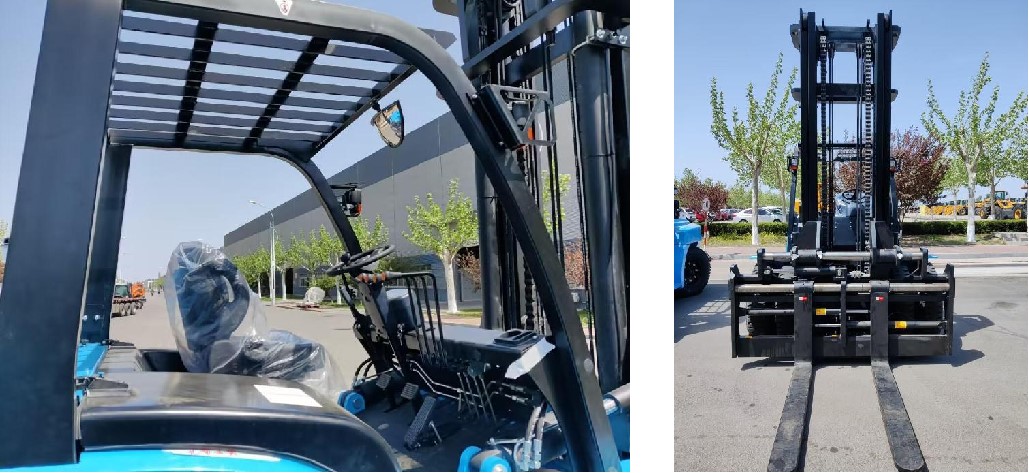Maintenance And Use Guide For Heavy Duty Forklift
Nov 01, 2023Heavy Duty Forklift as a traditional diesel forklift, its maintenance and use is more troublesome than small tonnage internal combustion forklift, and need to pay attention to more places, understanding and mastering the basic maintenance and use of the guide to extend the service life of the forklift is extremely important, NEOlift will discuss with you some tips for maintenance and use.
Heavy duty diesel forklift maintenance is very important to ensure its continuous and efficient operation and extend its service life. Here are some common steps to maintain a heavy-duty diesel forklift:
1. Daily cleaning: Keeping the forklift clean can prevent dust and dirt accumulation and reduce component wear. Clean the body, wheels, and engine areas regularly, and make sure the working area around the forklift is clean.
2. Engine maintenance: Replace engine oil and filter regularly to ensure normal engine operation. Check water temperature and oil pressure to repair any oil spills or coolant leaks.
3. Anti-corrosion coating: For the metal surface of the fuel forklift truck, you can consider using preservatives or anti-rust paint for coating treatment to protect the body from corrosion and oxidation.
4. Tire maintenance: Check tire wear and pressure, and replace and rotate tires regularly according to the manufacturer's recommendations. Make sure the tire fastening bolts are secure.
5. Battery maintenance: If the forklift uses an electric system, check and maintain the battery regularly. Keep the battery clean and ensure that the electrolyte level is appropriate and the battery terminal is clean.
6. Lubricating oil maintenance: regular inspection and replacement of lubricating oil, such as hydraulic oil and transmission oil. Ensure proper operation of the lubrication system to reduce friction and wear.
7. Regular inspection and maintenance: Regular inspection of key parts of the forklift, such as braking system, suspension system, steering system and lifting mechanism. Fix any problems found promptly to prevent further damage.
Please note that the actual maintenance procedures and frequency may vary by forklift model and manufacturer. It is best to perform maintenance operations according to the forklift's user manual and the manufacturer's recommendations. In addition, if you are not familiar with the repair and maintenance of forklifts, it is recommended to consult a professional forklift service.

Use Tips:
1. Safety equipment: Before operating the forklift, ensure that you wear appropriate personal protective equipment, such as safety shoes, hard hats and gloves. This will help reduce the potential risk of injury.
2. Check the status of the forklift: Before using the forklift, check the status of the vehicle, including brakes, lights, horns and mirrors. Ensure that all functions are functioning properly to ensure safe operation.
3. Familiar with forklift control: familiar with various control devices of forklift, including brake, accelerator, steering wheel, transmission and reversing device. Make sure you understand what each control does and how it operates.
4. Adjust the seat and mirror: Before operating the forklift, adjust the seat and mirror to ensure that you have a clear view and can comfortably operate the forklift.
5. Maintain stability: Ensure the stability of the forklift during operation. When lifting the cargo, place the cargo in the stable area of the fork arm and ensure that the fork arm is fully inserted into the cargo. Follow proper lifting and lowering procedures to ensure the stability of the forklift.
6. Pay attention to the surrounding environment: When operating the forklift, always keep your attention and observe the surrounding environment. Take care to avoid obstacles, uneven ground, and other vehicles or pedestrians. Make sure you have enough space to operate and follow traffic rules and safety signs.
7. Reasonable driving speed: Drive the forklift at an appropriate speed, not too fast or too slow. Too fast a speed may lead to loss of control and collision, while too slow a speed may lead to inflexible operation.
8. Study the work area: Before operating the forklift, study the area where you will be working. Understand the condition of the floor, the location of the equipment, and other factors that may affect operation. This can help you make a reasonable operation plan and avoid potential hazards.